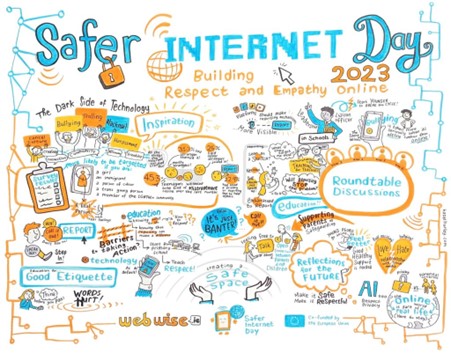Safer Internet Day (SID) has become a global landmark event in the online safety calendar with 2023 being its 20th year. Safer Internet Day is an EU wide initiative to promote a safer internet for all users, especially young people.

In Ireland, for Safer Internet Day 2023, the Irish Safer Internet Centre promoted the theme of respect and empathy online. Almost 200,000 young people and children took part in initiatives around the country to mark this milestone anniversary.
The annual awareness initiative is a great opportunity to get children and young people involved and talking about online safety, highlighting the benefits and recognising the challenges online.
One challenge in particular that the Irish Safer Internet Centre reflected on is online bullying – it is the most common negative experience children encounter online in Ireland. To explore this topic in more depth, the following four initiatives were undertaken as part of Safer Internet Day 2023 celebrations:
- Webwise launched the Silent Witness online bullying awareness campaign;
- Youth-led Safer Internet Day event to discuss and reflect on the theme of building respect and empathy online;
- Webwise, in partnership with DCU Anti-bullying Centre, published the Research Report on Bystander Behaviour;
- 100 Webwise Safer Internet Day Ambassadors led online safety and anti-bullying initiatives in schools and communities across Ireland.
Thank you to the hundreds of children, young people, teachers, school staff, parents/guardians and many other organisations for making Safer Internet Day the biggest in Ireland to date!
The SID 2023 report and research findings from the joint research study of bystander behaviour online among young people in Ireland, commissioned by Webwise and conducted by the DCU Anti-Bullying Centre, is available on the Irish SIC website.

Bystander behaviour online among young people in Ireland
Research shows that cyberbullying is a significant issue encountered online by children in Ireland. Researchers and educators recognise the importance of the role of peer bystanders in bullying situations, but more research is needed in this regard within an Irish context.
Moreover, there appears to be a general lack of literature on the role of bystanders in cyberbullying situations. Therefore, this research study commissioned by Webwise was conducted by DCU Anti-Bullying Centre and aims to explore online bystander behaviour among young people in Ireland.
A sample consisting of 212 students aged 13 to 17 years completed an online survey including questions regarding participants use of the internet and digital devices and bystander behaviour.
Key findings
- There is a high online connectivity among young people in Ireland. Most students in the sample had a mobile phone with internet access (98.1 per cent), and the average age for getting the first smartphone was 11.72 years old.
- Cyberbullying is frequently witnessed online, with 45.3 per cent of students surveyed report witnessing some kind of mistreatment online over the last months, being therefore cyberbullying bystanders.
- Various forms of direct verbal abuse are the most common type of cyberbullying. From those who witnessed cyberbullying, 64.6 per cent reported name calling, and mockery or insults were also witnessed by 63.5 per cent of the bystanders.
- The space where cyberbullying most often takes place is social media. Of the bystanders, 60.4 per cent reported having witnessed cyberbullying on a social network.
- Among those who reported witnessing cyberbullying, 31.3 per cent said a stranger started it and 25 per cent said other strangers joined in.
- Participants are in general aware of protective mechanisms provided by social networks, and report using those mechanisms to protect themselves, but not so much to help others. The most common mechanism for helping other people is the report button used by 14.2 per cent of the sample.
- The preferred persons to talk about witnessing cyberbullying were parents/guardians and friends. Of the bystanders, 30.2 per cent told their parents about the cyberbullying witnessed and 29.2 per cent told their friends.
- Bystanders are heavier internet and digital device users that their non-bystander peers. The rate of bystanders interacting with content from other people in social media daily is 48.4 per cent, while for non-bystanders it is 24.3 per cent.
- Participants comments tend to diminish the impact of cyberbullying compared to offline victimisation, but only a few recommend ignoring it. The main advice participants would give to people who are bullied online is to report in the platform and tell a trusted adult or a friend.
Find out more about the work of the Irish Safer Internet Centre, including its awareness raising, helpline, hotline, and youth participation services – or find similar information for Safer Internet Centres throughout Europe.
Safer Internet Day (SID) has become a global landmark event in the online safety calendar with 2023 being its 20th year. Safer Internet Day is an EU wide initiative to promote a safer internet for all users, especially young people.

In Ireland, for Safer Internet Day 2023, the Irish Safer Internet Centre promoted the theme of respect and empathy online. Almost 200,000 young people and children took part in initiatives around the country to mark this milestone anniversary.
The annual awareness initiative is a great opportunity to get children and young people involved and talking about online safety, highlighting the benefits and recognising the challenges online.
One challenge in particular that the Irish Safer Internet Centre reflected on is online bullying – it is the most common negative experience children encounter online in Ireland. To explore this topic in more depth, the following four initiatives were undertaken as part of Safer Internet Day 2023 celebrations:
- Webwise launched the Silent Witness online bullying awareness campaign;
- Youth-led Safer Internet Day event to discuss and reflect on the theme of building respect and empathy online;
- Webwise, in partnership with DCU Anti-bullying Centre, published the Research Report on Bystander Behaviour;
- 100 Webwise Safer Internet Day Ambassadors led online safety and anti-bullying initiatives in schools and communities across Ireland.
Thank you to the hundreds of children, young people, teachers, school staff, parents/guardians and many other organisations for making Safer Internet Day the biggest in Ireland to date!
The SID 2023 report and research findings from the joint research study of bystander behaviour online among young people in Ireland, commissioned by Webwise and conducted by the DCU Anti-Bullying Centre, is available on the Irish SIC website.

Bystander behaviour online among young people in Ireland
Research shows that cyberbullying is a significant issue encountered online by children in Ireland. Researchers and educators recognise the importance of the role of peer bystanders in bullying situations, but more research is needed in this regard within an Irish context.
Moreover, there appears to be a general lack of literature on the role of bystanders in cyberbullying situations. Therefore, this research study commissioned by Webwise was conducted by DCU Anti-Bullying Centre and aims to explore online bystander behaviour among young people in Ireland.
A sample consisting of 212 students aged 13 to 17 years completed an online survey including questions regarding participants use of the internet and digital devices and bystander behaviour.
Key findings
- There is a high online connectivity among young people in Ireland. Most students in the sample had a mobile phone with internet access (98.1 per cent), and the average age for getting the first smartphone was 11.72 years old.
- Cyberbullying is frequently witnessed online, with 45.3 per cent of students surveyed report witnessing some kind of mistreatment online over the last months, being therefore cyberbullying bystanders.
- Various forms of direct verbal abuse are the most common type of cyberbullying. From those who witnessed cyberbullying, 64.6 per cent reported name calling, and mockery or insults were also witnessed by 63.5 per cent of the bystanders.
- The space where cyberbullying most often takes place is social media. Of the bystanders, 60.4 per cent reported having witnessed cyberbullying on a social network.
- Among those who reported witnessing cyberbullying, 31.3 per cent said a stranger started it and 25 per cent said other strangers joined in.
- Participants are in general aware of protective mechanisms provided by social networks, and report using those mechanisms to protect themselves, but not so much to help others. The most common mechanism for helping other people is the report button used by 14.2 per cent of the sample.
- The preferred persons to talk about witnessing cyberbullying were parents/guardians and friends. Of the bystanders, 30.2 per cent told their parents about the cyberbullying witnessed and 29.2 per cent told their friends.
- Bystanders are heavier internet and digital device users that their non-bystander peers. The rate of bystanders interacting with content from other people in social media daily is 48.4 per cent, while for non-bystanders it is 24.3 per cent.
- Participants comments tend to diminish the impact of cyberbullying compared to offline victimisation, but only a few recommend ignoring it. The main advice participants would give to people who are bullied online is to report in the platform and tell a trusted adult or a friend.
Find out more about the work of the Irish Safer Internet Centre, including its awareness raising, helpline, hotline, and youth participation services – or find similar information for Safer Internet Centres throughout Europe.
- Safer Internet Centre (SIC) hate speech education cyberviolence cyberbullying campaign
Related content
- < Previous article
- Next article >












